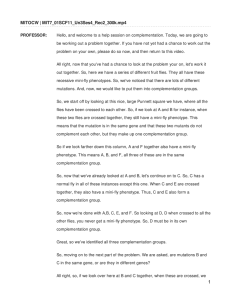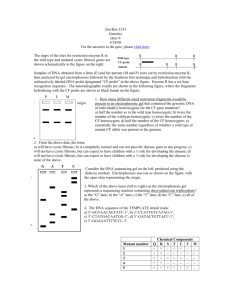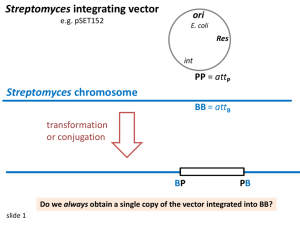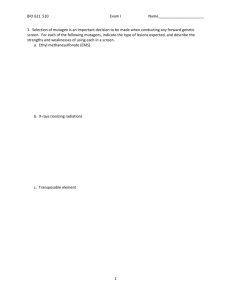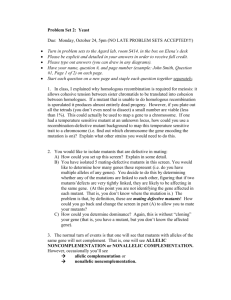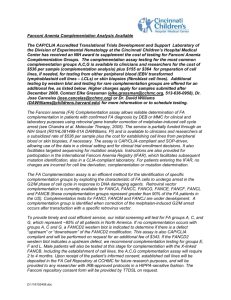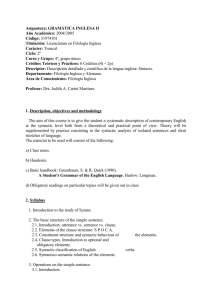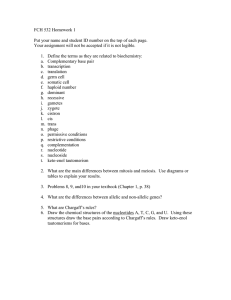7.344 Directed Evolution: Engineering Biocatalysts
advertisement
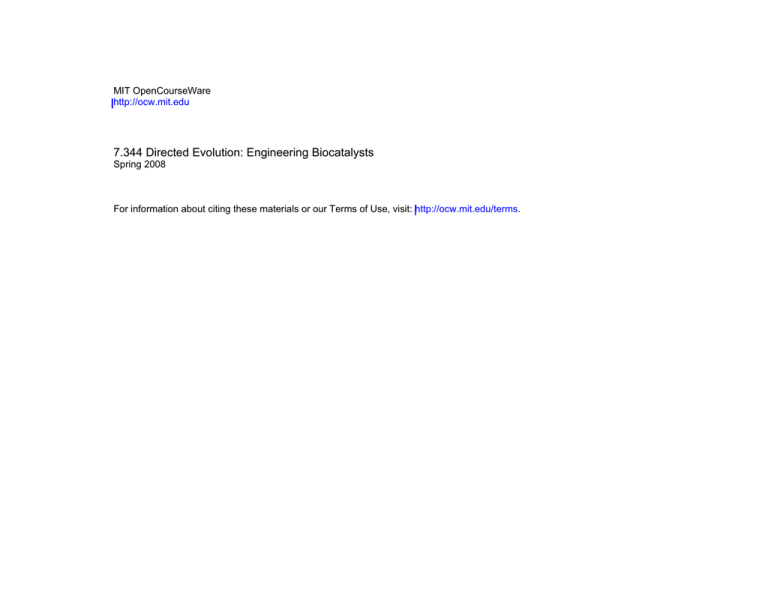
MIT OpenCourseWare http://ocw.mit.edu 7.344 Directed Evolution: Engineering Biocatalysts Spring 2008 For information about citing these materials or our Terms of Use, visit: http://ocw.mit.edu/terms. Enzyme evolution by chemical complementation Baker, K.; Bleczinski, C.; Lin, H.; Salazar-Jimenez, G.; Sengupta, D.; Krane, S.; Cornish, V.W. Chemical complementation: a reactionindependent genetic assay for enzyme catalysis. Proc. Natl. Acad. Sci. USA 2002, 99 (26), 16537-16542. Azizi, B.; Chang, E.I.; Doyle, D.F. Chemical complementation: smallmolecule-based genetic selection in yeast. Biochem. Biophys. Res. Commun. 2003, 306, 774-780. Lin, H.; Tao, H.; Cornish, V.W. Directed evolution of a glycosynthase via chemical complementation. J. Am. Chem. Soc. 2004, 126, 15051-15059. Chemical complementation as developed in the Cornish lab • What are the authors trying to do? • How do they go about engineering their system of complementation? • What enzyme do they use to test their system? How does this work? (Figure 2, panel B) • What are the results? (Figure 3, panels B and C) How do the authors confirm that the change in transcription is caused by enzyme turnover? • Is this strategy general? What are the benefits and pitfalls? The Cornish group strategy Transcriptional Activator (B42) E DHFR SUBSTRATE GR DNA binding Domain (LexA) LacZ reporter gene Chemical complementation for detection of cephalosporinase activity B42 B42 E cephalosporinase DHFR H N S Dex H N S DHFR HO N O S N O GR Mtx O O O LexA LexA binding site GR SH O Mtx Dex LexA lacZ reporter gene LexA binding site lacZ reporter gene How is enzyme activity reported? How are the enzymes tested with the substrates for activity? What chemical functional group is detected? Detection of free thiols (RSH) using Ellman’s reagent NO2 NO2 COOH RSH HS S COOH TNB S NO2 COOH S R S NO2 Thiol DTNB Mixed disulphide COOH MCD is a good in vivo substrate Images of plate assay and liquid culture assay using Ellman’s reagent removed due to copyright restrictions. Active enzyme can be isolated from inactive variants Image removed due to copyright restrictions. Please see Fig. 1 in Baker, K., C. Bleczinski, H. Lin, G. Salazar-Jimenez, D. Sengupta, S. Krane, and V. W. Cornish. “Chemical complementation: a reaction-independent genetic assay for enzyme catalysis.” PNAS. 99(2002):16537-16542. Chemical complementation as developed by the Doyle lab • What are the authors trying to do? • How do they go about engineering their system of complementation? • What enzyme do they use to test their system? How does this work? • What are the results? • Is this strategy general? What are the benefits and pitfalls? • Can you see why this paper got much less attention than the previous one? Doyle’s system of chemical complementation Image removed due to copyright restrictions. Please see Fig. 1 in Azizi, B, E. I. Chang, and D. F. Doyle. “Chemical complementation: smallmolecule-based genetic selection in yeast.” Biochem. Biophys. Res. Commun. 306(2003): 774-780. Genetic selection using the system Retinoid receptor Image removed due to copyright restrictions. Please see Fig. 3 in Azizi, B, E. I. Chang, and D. F. Doyle. “Chemical complementation: small-molecule-based genetic selection in yeast.” Biochem. Biophys. Res. Commun. 306(2003): 774-780. Pregnane receptor Image removed due to copyright restrictions. Please see Fig. 4 in Azizi, B, E. I. Chang, and D. F. Doyle. “Chemical complementation: small-molecule-based genetic selection in yeast.” Biochem. Biophys. Res. Commun. 306(2003): 774-780. Mutant LBDs can be better than WT Image removed due to copyright restrictions. Please see Fig. 6 in Azizi, B, E. I. Chang, and D. F. Doyle. “Chemical complementation: smallmolecule-based genetic selection in yeast.” Biochem. Biophys. Res. Commun. 306(2003): 774-780. Enzyme evolution by chemical complementation • What are the authors trying to do? • How do they go about engineering their system of complementation? • What enzyme do they use to test their system? How does this work? (Figure 2) • What are the results? (Figure 5) • How do they evolve this enzyme? What is the library generation strategy? How do they characterize the mutants? • Is this strategy general? What are the benefits and pitfalls? Chemical complementation for complex carbohydrate synthesis Image removed due to copyright restrictions. Please see Fig. 1 in Lin, H., H. Tao, and V. W. Cornish. “Directed evolution of a glycosynthase via chemical complementation.” J. Am. Chem. Soc. 126(2004): 15051-15059. Making a glycosidase into a glycosynthase Image removed due to copyright restrictions. Please see Fig. 2 in Lin, H., H. Tao, and V. W. Cornish. “Directed evolution of a glycosynthase via chemical complementation.” J. Am. Chem. Soc. 126(2004): 15051-15059. Chemical complementation links glycosylation activity to LEU2 transcription Image removed due to copyright restrictions. Please see Fig. 6 in Lin, H., H. Tao, and V. W. Cornish. “Directed evolution of a glycosynthase via chemical complementation.” J. Am. Chem. Soc. 126(2004): 15051-15059.
